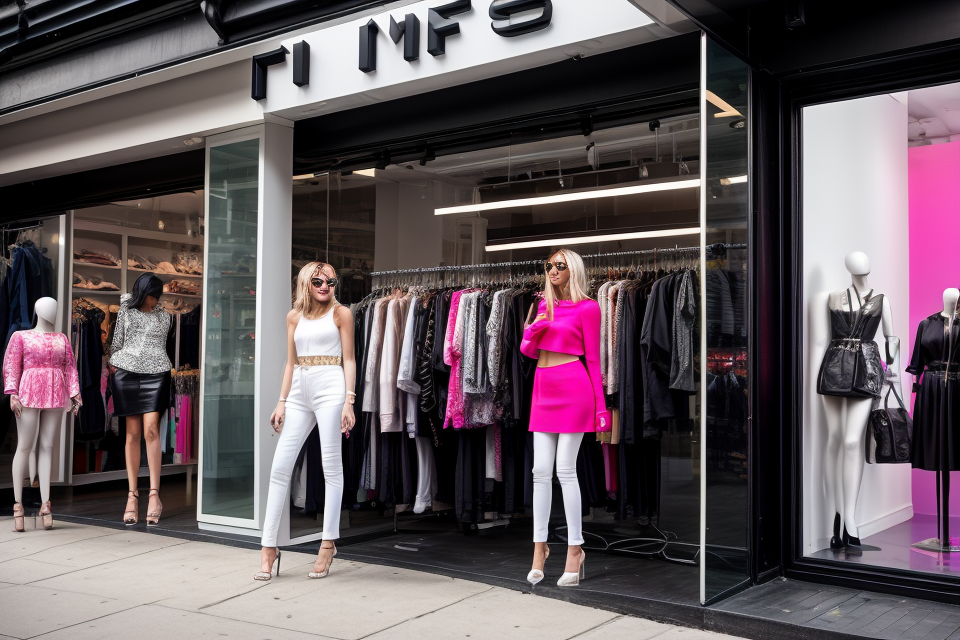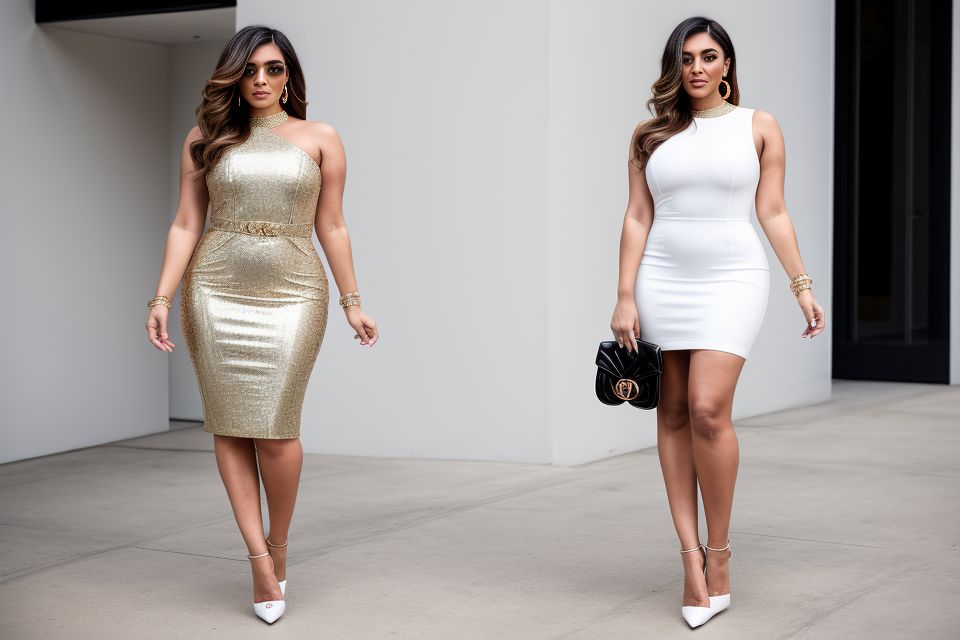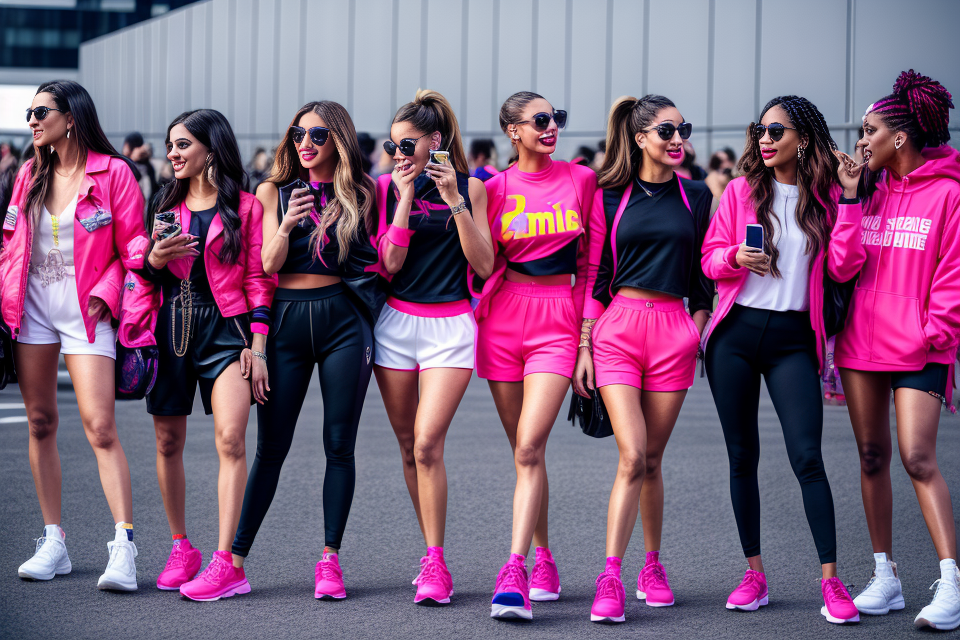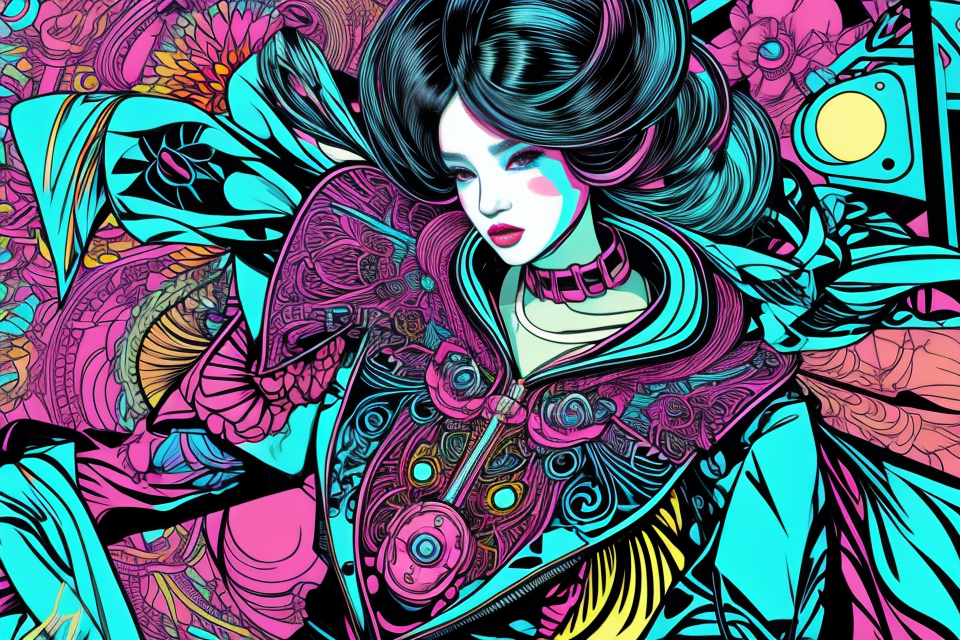Social media has revolutionized the way we consume and share information, including fashion trends. With billions of people using platforms like Instagram, Twitter, and Facebook, it’s no surprise that social media has a significant impact on the fashion industry. From influencing what’s in style to shaping the way brands market their products, social media has become an essential tool for fashion designers, retailers, and consumers alike. In this article, we’ll explore how social media affects fashion trends and the ways in which it’s changing the fashion industry.
Social media has a significant impact on fashion trends. It allows individuals to share their personal style and opinions on fashion with a wide audience, creating a community of fashion influencers. These influencers can shape public opinion on what is considered fashionable, and trends can spread rapidly through social media platforms. Social media also provides access to a vast amount of information on fashion, including runway shows, fashion weeks, and designer collections, making it easier for individuals to stay up-to-date on the latest trends. Additionally, social media has enabled the rise of fast fashion, where retailers can quickly produce and sell trendy clothing at affordable prices, making it easier for consumers to follow the latest fashion trends.
The Power of Social Media on Fashion
The Influence of Celebrities and Influencers
Celebrities have long been regarded as fashion icons, with their style choices influencing the masses. However, with the rise of social media, the power of celebrities has been amplified, as they now have direct access to their fans through various platforms. This has led to a situation where a celebrity’s outfit can instantly become a trend, with countless individuals emulating their look.
Another factor contributing to the influence of celebrities on fashion trends is the proliferation of social media influencers. These individuals have amassed large followings by sharing their personal lives and opinions on various platforms, including fashion. As a result, their endorsements and fashion choices carry significant weight, and they can often single-handedly spark a trend.
Furthermore, the rise of influencer marketing has played a crucial role in shaping fashion trends. Brands now collaborate with influencers to promote their products, creating a symbiotic relationship where the influencer’s fashion choices can drive sales, and the brand can provide the influencer with exclusive access to their latest collections. This relationship has only served to amplify the influence of social media on fashion trends, as influencers have become key opinion leaders in the industry.
Overall, the influence of celebrities and influencers on fashion trends cannot be overstated. Their reach and power have been significantly enhanced by social media, leading to a situation where a single Instagram post or tweet can spark a trend and influence the fashion choices of millions.
The Role of Social Media Platforms
In today’s digital age, social media has become an integral part of our lives, and it has also significantly impacted the fashion industry. Here’s how different social media platforms play a role in shaping fashion trends:
Instagram and its fashion community
Instagram is one of the most popular social media platforms, with over 1 billion active users. It has become a go-to platform for fashion enthusiasts, designers, and brands to showcase their work, connect with others, and stay up-to-date with the latest fashion trends.
- Instagram has a large and active fashion community, with many influencers and bloggers sharing their outfit of the day (OOTD) and other fashion-related content.
- Many fashion brands and designers have an Instagram account, where they share their latest collections, campaigns, and behind-the-scenes content.
- Instagram has also become a platform for fashion weeks, where designers showcase their collections and get feedback from the audience.
TikTok and viral fashion trends
TikTok is a relatively new social media platform, but it has already made a significant impact on fashion trends. The platform’s algorithm-driven feed means that trends can quickly go viral, and users can easily discover new fashion styles and trends.
- TikTok has been responsible for popularizing many fashion trends, such as the “uniform” trend, where users wear the same outfit every day for a week.
- The platform has also led to the rise of micro-trends, where small groups of users adopt a specific style or fashion item, leading to a sudden increase in popularity.
- TikTok has also been used by fashion brands to launch new products and campaigns, leveraging the platform’s viral nature to generate buzz and engagement.
Twitter and real-time fashion discussions
Twitter is a platform that is often used for real-time discussions and news updates. It has become a go-to platform for fashion enthusiasts to discuss the latest trends, share their opinions, and engage with others.
- Twitter has a large and active fashion community, with many users sharing their thoughts and opinions on the latest fashion trends and news.
- The platform has also been used by fashion journalists and critics to share their insights and opinions on the latest fashion shows and collections.
- Twitter has also become a platform for fashion polls and debates, where users can vote on their favorite fashion trends and engage in discussions about the industry.
In conclusion, social media has become an essential tool for the fashion industry, providing a platform for designers, brands, and enthusiasts to connect, share, and stay up-to-date with the latest trends. From Instagram’s fashion community to TikTok’s viral trends, social media has significantly impacted the way we think about and engage with fashion.
The Changing Landscape of Fashion Journalism
In recent years, the world of fashion journalism has undergone a significant transformation, thanks in large part to the rise of social media. This shift has led to a decline in the influence of traditional fashion magazines, while at the same time, digital fashion media has gained more prominence. Furthermore, social media has had a profound impact on fashion criticism and commentary, changing the way in which consumers engage with the industry.
One of the most notable changes in the fashion journalism landscape has been the decline of traditional fashion magazines. These publications, which were once the primary source of information and analysis for fashion enthusiasts, have seen their readership decline in the face of the digital revolution. As social media has become more prevalent, people have increasingly turned to online sources for their fashion news and analysis, leading to a decline in the relevance of traditional fashion magazines.
At the same time, digital fashion media has risen to prominence, offering consumers a new way to stay up-to-date on the latest trends and developments in the industry. These online publications often have a more casual and accessible tone than traditional fashion magazines, making them more appealing to younger audiences. In addition, they are able to publish content more frequently, allowing them to keep up with the fast-paced nature of the fashion industry.
Another significant impact of social media on fashion journalism has been the way in which it has changed the nature of fashion criticism and commentary. In the past, fashion critics were largely confined to traditional print publications, where their opinions carried a great deal of weight. However, with the rise of social media, anyone with an internet connection can now share their thoughts on the latest fashion trends, leading to a much more democratic and diverse fashion discourse. This has had both positive and negative effects on the industry, as it has allowed for a wider range of voices to be heard, but has also led to a proliferation of often-uninformed opinions.
Overall, the changing landscape of fashion journalism is a direct result of the rise of social media, and it has had a profound impact on the way in which people engage with the fashion industry. While traditional fashion magazines may be in decline, digital fashion media has risen to take their place, offering consumers a new way to stay informed and engaged with the latest trends. Additionally, the democratization of fashion criticism and commentary has led to a much more diverse and dynamic fashion discourse, with a wider range of voices being heard.
Fashion Trends and Social Media
Fast Fashion and Social Media
Fast fashion is a relatively new phenomenon that has gained significant popularity in recent years. It refers to the mass-produced clothing that is designed to be fashionable and affordable, often following the latest fashion trends. The rise of fast fashion has been closely linked to the emergence of social media as a powerful marketing tool for fashion brands.
- The emergence of fast fashion brands
The fast fashion industry emerged in the 1990s, with the emergence of brands such as Zara, H&M, and Forever 21. These brands revolutionized the fashion industry by offering trendy, affordable clothing that was easily accessible to the masses. They achieved this by reducing the time it took to bring new styles to market, using data-driven approaches to anticipate consumer demand, and relying on a global supply chain to source materials and labor.
- The role of social media in promoting fast fashion
Social media has played a significant role in promoting fast fashion brands. By leveraging platforms such as Instagram, Facebook, and TikTok, fashion brands can reach a massive audience and showcase their latest products in a visually appealing way. Influencers and celebrities often endorse fast fashion brands, further boosting their popularity and reach.
Furthermore, social media has made it easier for fast fashion brands to gather data on consumer preferences and trends. By analyzing social media data, brands can identify which styles and colors are most popular and adjust their production accordingly. This data-driven approach has allowed fast fashion brands to remain relevant and responsive to changing consumer demands.
- The environmental and ethical implications of fast fashion
However, the rise of fast fashion has also led to concerns about its environmental and ethical implications. Fast fashion is known for its high levels of waste and pollution, as well as its exploitation of workers and use of sweatshop labor. Many critics argue that the fast fashion model is unsustainable and that it promotes a culture of overconsumption and waste.
Moreover, social media has amplified these concerns by making it easier for consumers to learn about the environmental and ethical issues associated with fast fashion. As a result, some consumers have turned to more sustainable and ethical alternatives, such as vintage clothing, upcycling, and slow fashion.
Overall, social media has had a significant impact on the fast fashion industry, both in terms of promoting its growth and in raising awareness of its environmental and ethical implications. As the fashion industry continues to evolve, it will be interesting to see how social media continues to shape fashion trends and consumer behavior.
Street Style and Social Media
In recent years, street style fashion has become increasingly popular, and social media has played a significant role in its rise. With the advent of social media platforms such as Instagram and Tumblr, individuals have been able to share their personal style and fashion choices with a wider audience, creating a global community of fashion enthusiasts.
One of the key ways in which social media has impacted street style trends is by providing a platform for individuals to showcase their unique style and personal sense of fashion. By sharing images and videos of their outfits on social media, individuals have been able to gain followers and a dedicated audience, who are interested in their style and fashion choices. This has created a new form of influence, where individuals with a strong personal style can become fashion icons and trendsetters, shaping the way that others dress.
Another way in which social media has impacted street style trends is by providing a platform for the globalization of fashion. With social media, individuals from all over the world can connect and share their fashion choices, creating a global community of fashion enthusiasts. This has led to the emergence of new trends and styles, as individuals are exposed to a wider range of fashion choices and influences.
Additionally, social media has also enabled brands and designers to reach a wider audience and showcase their designs to a global market. By leveraging the power of social media, brands and designers can now connect with consumers directly, showcasing their latest collections and trends, and building a following of dedicated customers.
Overall, social media has had a significant impact on street style fashion, providing a platform for individuals to showcase their personal style, connect with a global community of fashion enthusiasts, and enabling brands and designers to reach a wider audience.
Sustainable Fashion and Social Media
The growing importance of sustainable fashion
In recent years, sustainable fashion has become an increasingly important topic in the fashion industry. As consumers become more aware of the environmental impact of fast fashion, they are seeking out more sustainable and ethical alternatives. This has led to a rise in sustainable fashion brands and a greater focus on eco-friendly practices within traditional fashion companies.
The role of social media in promoting sustainable fashion
Social media has played a significant role in the growth of sustainable fashion. Platforms like Instagram and TikTok have provided a space for sustainable fashion influencers to share their message with a wider audience. These influencers often showcase their own sustainable fashion choices and share tips on how to be more environmentally conscious in one’s fashion choices.
Additionally, social media has made it easier for sustainable fashion brands to reach a wider audience. Many of these brands have found success by using social media to build a community of like-minded individuals who are passionate about sustainable fashion.
The challenges and opportunities of sustainable fashion on social media
While social media has provided a platform for sustainable fashion to grow, it also presents some challenges. One of the main challenges is the prevalence of “fast fashion” on social media. Fast fashion brands often use influencer marketing and social media advertising to promote their products, which can make it difficult for sustainable fashion brands to stand out.
However, there are also opportunities for sustainable fashion on social media. For example, many sustainable fashion brands have found success by partnering with influencers who align with their values. Additionally, social media platforms are beginning to take steps to address the environmental impact of the fashion industry. For example, Instagram has launched a feature that allows users to see the environmental impact of their feed and make more sustainable choices.
Overall, social media has played a significant role in the growth of sustainable fashion. While there are challenges to be faced, there are also opportunities for sustainable fashion brands to thrive on social media.
The Future of Fashion and Social Media
The Impact of Virtual Reality and Augmented Reality
- The potential of VR and AR in fashion
- Virtual fashion shows: A new way to showcase collections
- Offering a more interactive and immersive experience for audiences
- Allowing designers to present their collections in unique and innovative ways
- Try-on technology: Enhancing the online shopping experience
- Providing customers with a more realistic representation of how clothing would look on them
- Enabling them to make more informed purchasing decisions
- Virtual fashion collaborations and creations: Expanding design possibilities
- Bringing together designers from different backgrounds and locations to work on projects
- Enabling the creation of virtual collections that can be brought to life in the real world
- Virtual fashion shows: A new way to showcase collections
- The impact of virtual fashion shows and try-on technology
- Changing the way fashion shows are conducted
- Providing a more cost-effective and sustainable alternative to traditional runway shows
- Allowing for greater flexibility in terms of location and audience size
- Transforming the online shopping experience
- Offering customers a more engaging and interactive way to explore and purchase fashion items
- Providing retailers with valuable data on customer preferences and behavior
- Changing the way fashion shows are conducted
- The potential for virtual fashion collaborations and creations
- Breaking down geographical barriers and fostering international partnerships
- Connecting designers from different parts of the world to work on joint projects
- Creating new and innovative fashion trends through the exchange of ideas and inspiration
- Expanding the boundaries of fashion design
- Providing a platform for emerging designers to showcase their work and gain exposure
- Offering new opportunities for sustainable fashion
- Reducing the environmental impact of fashion through the use of digital technology
- Encouraging the adoption of more sustainable practices within the industry
- Breaking down geographical barriers and fostering international partnerships
The Ethics of Social Media and Fashion
Social media has revolutionized the way we interact with fashion, allowing us to see the latest trends and styles from around the world. However, with this power comes responsibility, and it is important to consider the ethical implications of social media’s influence on fashion.
- The role of social media in promoting diversity and inclusivity in fashion
Social media has the potential to promote diversity and inclusivity in fashion by showcasing a wide range of body types, ages, and ethnicities. This can help to break down traditional beauty standards and promote a more inclusive and diverse fashion industry. However, it is important to ensure that these representations are authentic and not just a superficial attempt to capitalize on a trend.
- The potential for social media to drive positive change in the fashion industry
Social media can also be a powerful tool for driving positive change in the fashion industry. By using social media to raise awareness about issues such as sustainability and ethical labor practices, consumers can hold fashion brands accountable for their actions and encourage them to make positive changes.
- The challenges of regulating social media and fashion content
Despite its potential for good, social media also poses challenges when it comes to regulating fashion content. With so much content being generated and shared every day, it can be difficult to ensure that all of it is accurate and ethical. This is particularly true when it comes to influencer marketing, where sponsored posts can often be misleading or deceptive. It is important for social media platforms and fashion brands to work together to establish clear guidelines and regulations for fashion content on social media.
The Evolution of Fashion and Social Media
The ongoing relationship between fashion and social media
In recent years, social media has become an integral part of the fashion industry. Fashion brands, designers, and influencers have all embraced social media platforms like Instagram, Facebook, and Twitter to showcase their work, connect with customers, and promote their products. The constant stream of images and videos on social media has also created a culture of instant gratification, where people expect to see the latest fashion trends as soon as they are released.
The potential for new technologies to shape the future of fashion
As technology continues to advance, it is likely that new innovations will play a significant role in shaping the future of fashion. Virtual reality (VR) and augmented reality (AR) technologies are already being used by some fashion brands to create immersive shopping experiences and to showcase their products in new and innovative ways. Other technologies, such as artificial intelligence (AI) and 3D printing, are also being explored for their potential to revolutionize the fashion industry.
The importance of critical thinking and awareness in the era of social media and fashion
As social media continues to shape the fashion industry, it is important for consumers to be critical thinkers and to be aware of the messages that are being conveyed through social media. Social media can be a powerful tool for promoting body positivity, diversity, and inclusivity in fashion, but it can also perpetuate harmful stereotypes and unrealistic beauty standards. Consumers should be mindful of the messages they are receiving and should strive to support brands and influencers who promote positive and realistic images of fashion.
FAQs
1. How does social media influence fashion trends?
Social media has become a powerful tool for fashion brands and designers to showcase their products and reach a wider audience. Through platforms like Instagram, Twitter, and Facebook, people can share their opinions and preferences about fashion trends, which can impact the decisions of others. Social media also allows fashion influencers and celebrities to promote specific styles and brands, which can have a significant impact on the fashion industry.
2. Can social media create new fashion trends?
Yes, social media can create new fashion trends. With the rise of social media platforms, fashion trends can spread quickly and widely, making them more accessible to a wider audience. Social media influencers and celebrities often set the tone for what’s popular, and their followers will often emulate their style. Additionally, social media has made it easier for new designers and brands to gain exposure and followers, leading to the emergence of new fashion trends.
3. How do fashion brands use social media to promote their products?
Fashion brands use social media to promote their products in various ways. They may collaborate with social media influencers to showcase their products, create engaging content to attract followers, and use targeted advertising to reach specific audiences. Brands may also use social media to create a sense of community and engage with their customers, which can help build brand loyalty and increase sales.
4. Can social media be a source of negative influence on fashion trends?
Yes, social media can be a source of negative influence on fashion trends. Social media can promote unrealistic beauty standards and body types, leading to a negative impact on body image and self-esteem. Additionally, social media can perpetuate the fast fashion industry, which can have negative environmental and social impacts. However, it’s important to note that social media can also be a powerful tool for promoting positive change in the fashion industry, such as sustainable and ethical fashion practices.
5. How can I use social media to stay up-to-date on fashion trends?
To stay up-to-date on fashion trends, you can follow fashion influencers and brands on social media platforms like Instagram and Twitter. You can also join online fashion communities and forums to engage with other fashion enthusiasts and discuss the latest trends. Additionally, you can attend fashion events and shows, both in-person and online, to see the latest collections and learn about new trends.



